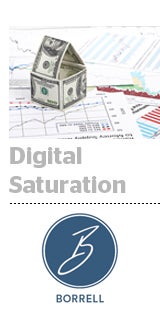 Has real estate advertising reached a digital saturation point? Borrell Associates, a research firm focusing on local advertising, says it has – at least for the agent and broker community.
Has real estate advertising reached a digital saturation point? Borrell Associates, a research firm focusing on local advertising, says it has – at least for the agent and broker community.
Digital ad spend among agents and brokers is projected to decline 2% – a $200 million drop – in 2015, according to a report the firm released Wednesday. It would be the first decrease in 20 years.
The real estate vertical saw $31.8 billion in ad spend last year, and agents and brokers are forecasted to spend the most in 2015 – $13.9 billion – with the biggest portion of their budgets on digital (75%). Mortgage lenders will spend a projected $12.3 billion in 2015, with 44% in digital; rental unit managers will spend $3.3 billion, with 52% in digital; and developers will spend $2.3 billion, with 69% in digital.
Ultimately, the digital saturation point for agents and brokers is 75% of real estate ad budgets, said CEO Gordon Borrell. Agents and brokers are first to hit the digital saturation point because they were early buyers in the online ad economy.
“People use the Internet to research products before they buy, and a home is the largest purchase a person will typically make in their lifetime,” explained Borrell. “Agents and brokers recognized this and were the first to rush to the Internet with listings and other information.”
Borrell couldn’t say whether shift in digital ad spend among agents and brokers will continue to decline or not.
“I can’t say definitively it’ll be a sustained decline, but I do think you won’t see agents and brokers increasing the share of their ad budgets going to digital media,” he said. “That’s the figure that needs to be observed more closely than the overall shrinkage or growth in dollars.”
So what’s projected to drop in digital? Online display, for one. Investments in online run-of-site (ROS) display from the agent and broker community have decreased 15.9% since 2014, with estimated 2015 spend at $511.9 million. Between 2014-2019, Borrell Associates expects a 92.2% decrease to $47.2 million.
Meanwhile, agents and brokers increased targeted display spend 2.1% to $4.9 billion between 2014 and 2015. However, Borrell Associates projects a 22.9% decrease to $3.7 billion between 2014-2019.
This shouldn’t be too much of a concern to realty hubs like Zillow or Realtor.com. Zillow, for instance, gets less than 20% of its revenue from display advertising, according to Borrell, accruing most of its revenue by exposing home listings within certain ZIP codes on a pay-per-click model.
But video advertising investments are growing, Borrell said.
“We’re seeing an 8% uptick in streaming video advertising for agents and brokers, which doesn’t seem like much unless you put it in the perspective that they’re actually scaling back digital a bit,” he said.
Streaming video investments among agents and brokers was $862.7 million, the company said. By 2019, that figure is expected to grow to $4.9 billion.
There are also modest investments in streaming audio. While agents and brokers reduced spend in the channel by 40.2% to $19.4 million from 2014 to 2015, by 2019 Borrell Associates expect a tremendous 2,300.2% increase, with streaming audio spend totaling $778.5 million.
In fact, among all the different stakeholders in real estate (agents/brokers, mortgage lenders, rental unit managers and developers), Borrell Associates projected only streaming video and streaming audio to see ad spend increases by 2019. Display, email and paid search will all decline, the company estimated.
Mobile investments are increasing as well, driven by millennials’ tendencies to rent and use mobile devices and online realty hubs like Zillow or Realtor.com to seek out listings.
Interestingly, millennial interest has also created a slight uptick in print advertising
Certainly, agents and brokers aren’t decreasing their overall ad spend, which rose 2.2% in 2014. (Rental unit managers saw the biggest overall ad spend increase in 2014 – 13.8% – followed by developers at 9.5% and mortgage lenders at 6%.)













